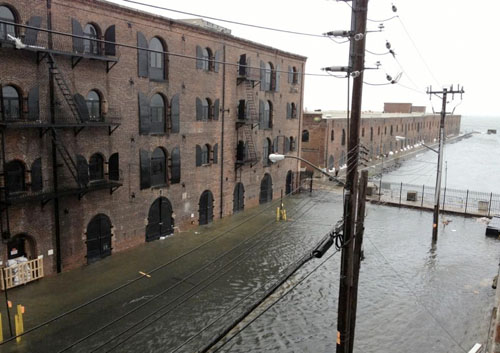As weather grows hotter, wetter and stormier—and insurance becomes harder to come by—some businesses are warming up to an esoteric tool that lets companies effectively place bets on weather events with few strings attached.
Parametric insurance, as it is called, remains a niche product, though it functions in a relatively straightforward way: It pays out when certain conditions, or parameters, are met.
Standard-issue insurance might cover flood damage or hail, but a parametric policy is tied directly to a weather event, paying, for example, if wind speed at a specific location gets above a certain level, or floodwaters reach a predetermined height. The data usually come from third parties, such as government weather agencies.
Bon Appétit Restaurant, a waterfront establishment in Dunedin, Fla., near Tampa, turned to a parametric policy to cover potential flood damage after finding it difficult to obtain conventional insurance in the state, which has been hit with high-profile insurer withdrawals, said Scott Estes, chief development officer for the restaurant’s operating company.
“Every year, the challenge is to place a policy that’s affordable. That has become more of a challenge,” Estes said.
Bon Appétit turned to FloodFlash, which installed sensors at the rear of the restaurant’s building. The FloodFlash policy will pay out when water levels hit 28 inches, and another payout is triggered if the water rises to 40 inches.
In parametric policies, though, a near miss doesn’t count. Bon Appétit won’t get anything if, for example, 27 inches of water floods the restaurant. But Estes said the business could make the numbers in its policy work, and that it was attracted by the speed of payouts. The carrier can cut a check in as fast as a week, Estes said, rather than months under a traditional policy.
Parametrics, because they are tied to the underlying weather, don’t require extensive work from loss adjusters, which increases their speed of payment. Bon Appétit is free to use the money to pay workers’ wages, or on cleanup or restocking inventory, Estes said.
Parametric insurance doesn’t just cover floods. It can be used for wind, lightning, wildfires, earthquakes or even excessive heat or cold. Insurers have for years tried to sell clients on the policies, which let the carriers tap their decades of historical data and their modeling capabilities.
Buyers so far haven’t necessarily flocked to the products, but insurers have recently faced climate-related pressures, along with economic conditions, that have increased prices or even prompted some to pull out of certain markets. Businesses are being driven to the parametric policies, which cover single, discrete risks, as they find it more difficult to obtain traditional policies.
Dangerous heat has blanketed much of the U.S. this summer. A tropical storm hit California for the first time in nearly a century. More broadly, natural disasters continue to cause major property damage. Globally, insurance covered an estimated $43 billion in natural disaster losses in the first six months of 2023, well above the average of the past 10 years, according to reinsurer Munich Re.
Derrick Easton, a managing director who heads the alternative risk team at broker WTW,, said he has never had more calls about the products.
“We’ve definitely seen an increase in inquiries,” said Matthew Dyk, the U.S. property practice parametric segment leader at broker Gallagher. “The property [insurance] marketplace is difficult and people are looking at alternatives.”
Parametrics can, unlike traditional policies, also cover weather events in areas a business doesn’t control.
A company could, for example, obtain coverage connected to the operation of an airport it uses, or a hotel near a theme park could take out insurance against weather events that shut that park down, said Cole Mayer, leader of worldwide parametric initiatives at professional-services firm Aon.
A heat-related product could, for example, cover a public agency’s costs related to unusually hot spells, or an interruption to a construction jobsite if temperatures reach levels that force workers to stop work, things a traditional policy wouldn’t cover.
Businesses have historically tended to shy away from these products because the product has been relatively unfamiliar.
They’re a little bit harder to understand,” said Susan Hiteshew, vice president of risk management at apartment rental company AvalonBay Communities and former board member of the risk professional society RIMS. “They’re not what everybody’s always bought.”
Any given parametric also only covers one component of risk, which can make companies wary of buying them, she said. A risk manager’s goal is ultimately to protect against all kinds of risks.
Still, despite the limitations on coverage in parametric policies, the difficult conditions for conventional insurance have spurred organizations to look for new solutions.
“In this type of market, everybody’s trying to think creatively,” Hiteshew said.













